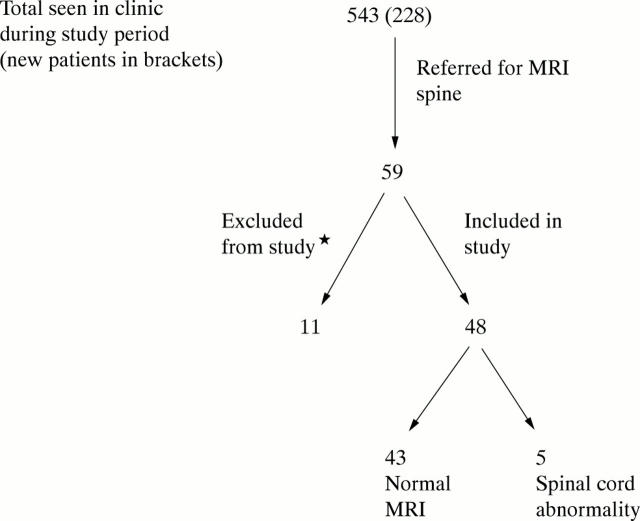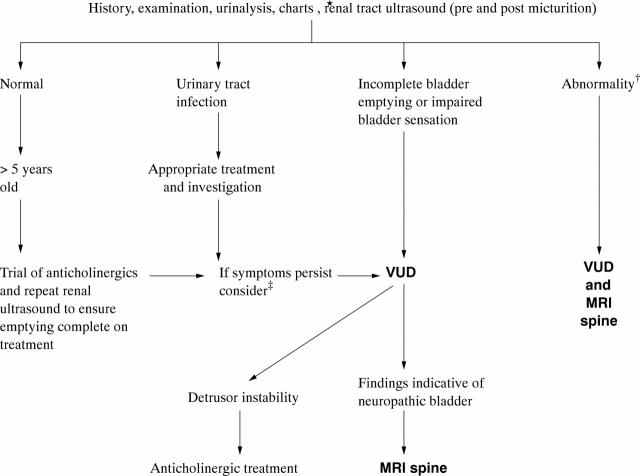Abstract
Aim: To clarify indications for magnetic resonance imaging (MRI) of the spine in children with voiding dysfunction.
Methods: Retrospective study of children with voiding dysfunction referred from the Guy's Hospital neurourology clinic for MRI spine between April 1998 and April 2000. Clinical notes and results of investigations, including urodynamic studies and MRI spine were reviewed.
Results: There were 48 children (median age 9.1 years). Closed spina bifida was detected in five, of whom four had neuropathic vesicourethral dysfunction confirmed by urodynamic studies. Impaired bladder sensation and incomplete bladder emptying were more frequent in these children than in those with normal MRI spine. One child with spinal cord abnormality had no cutaneous, neuro-orthopaedic, or lumbosacral spine x ray abnormalities.
Conclusion: Spinal cord imaging should be considered in children with daytime wetting when this is associated with impaired bladder sensation or poor bladder emptying, even in the absence of neuro-orthopaedic, cutaneous, or lumbosacral spine x ray abnormalities.
Full Text
The Full Text of this article is available as a PDF (98.9 KB).
Figure 1 .
Patients attending neurourology clinic during study period. *Reasons for exclusion: spinal cord pathology clinically apparent and radiologically defined prior to study period (n = 8), no voiding dysfunction (n = 3).
Figure 2 .
Suggested protocol for investigation of children with daytime wetting. *Frequency voided and volume voided charts. †Abnormalities include: lower limb neurological or orthopaedic abnormalities (e.g. talipes, absent ankle reflexes, sensory loss), midline birth marks lower back (including lipoma, deep sacral pit, hairy tuft), abnormal lumbosacral spine x ray (excluding failure of fusion L5/S1 vertebrae), anorectal abnormalities (e.g. anal atresia). In addition, family history of spina bifida, maternal insulin dependent diabetes, or persistent constipation or faecal soiling indicate need for VUD and consideration of MRI spine. ‡Particularly if other abnormalities coexist (e.g. constipation or faecal soiling).
Selected References
These references are in PubMed. This may not be the complete list of references from this article.
- Angelsen N. K., Vik T., Jacobsen G., Bakketeig L. S. Breast feeding and cognitive development at age 1 and 5 years. Arch Dis Child. 2001 Sep;85(3):183–188. doi: 10.1136/adc.85.3.183. [DOI] [PMC free article] [PubMed] [Google Scholar]
- Armon K., Stephenson T., MacFaul R., Eccleston P., Werneke U. An evidence and consensus based guideline for acute diarrhoea management. Arch Dis Child. 2001 Aug;85(2):132–142. doi: 10.1136/adc.85.2.132. [DOI] [PMC free article] [PubMed] [Google Scholar]
- Borzyskowski M. An update on the investigation of the child with a neuropathic bladder. Dev Med Child Neurol. 1996 Aug;38(8):744–748. doi: 10.1111/j.1469-8749.1996.tb12145.x. [DOI] [PubMed] [Google Scholar]
- Borzyskowski M., Mundy A. R. The management of the neuropathic bladder in childhood. Pediatr Nephrol. 1988 Jan;2(1):56–66. doi: 10.1007/BF00870381. [DOI] [PubMed] [Google Scholar]
- Borzyskowski M., Mundy A. R. Videourodynamic assessment of diurnal urinary incontinence. Arch Dis Child. 1987 Feb;62(2):128–131. doi: 10.1136/adc.62.2.128. [DOI] [PMC free article] [PubMed] [Google Scholar]
- Borzyskowski M., Neville B. G. Neuropathic bladder and spinal dysraphism. Arch Dis Child. 1981 Mar;56(3):176–180. doi: 10.1136/adc.56.3.176. [DOI] [PMC free article] [PubMed] [Google Scholar]
- Choo S., Finn A. New pneumococcal vaccines for children. Arch Dis Child. 2001 Apr;84(4):289–294. doi: 10.1136/adc.84.4.289. [DOI] [PMC free article] [PubMed] [Google Scholar]
- De Gennaro M., Lais A., Fariello G., Caldarelli M., Capozza N., Talamo M., Caione P. Early diagnosis and treatment of spinal dysraphism to prevent urinary incontinence. Eur Urol. 1991;20(2):140–145. doi: 10.1159/000471684. [DOI] [PubMed] [Google Scholar]
- Elliman D. A., Bedford H. E. MMR vaccine--worries are not justified. Arch Dis Child. 2001 Oct;85(4):271–274. doi: 10.1136/adc.85.4.271. [DOI] [PMC free article] [PubMed] [Google Scholar]
- Fone P. D., Vapnek J. M., Litwiller S. E., Couillard D. R., McDonald C. M., Boggan J. E., Stone A. R. Urodynamic findings in the tethered spinal cord syndrome: does surgical release improve bladder function? J Urol. 1997 Feb;157(2):604–609. [PubMed] [Google Scholar]
- Hain R. D., Campbell C. Invasive procedures carried out in conscious children: contrast between North American and European paediatric oncology centres. Arch Dis Child. 2001 Jul;85(1):12–15. doi: 10.1136/adc.85.1.12. [DOI] [PMC free article] [PubMed] [Google Scholar]
- Hellström A. L., Hanson E., Hansson S., Hjälmås K., Jodal U. Micturition habits and incontinence in 7-year-old Swedish school entrants. Eur J Pediatr. 1990 Mar;149(6):434–437. doi: 10.1007/BF02009667. [DOI] [PubMed] [Google Scholar]
- Johnston L. B., Borzyskowski M. Bladder dysfunction and neurological disability at presentation in closed spina bifida. Arch Dis Child. 1998 Jul;79(1):33–38. doi: 10.1136/adc.79.1.33. [DOI] [PMC free article] [PubMed] [Google Scholar]
- Kakizaki H., Nonomura K., Asano Y., Shinno Y., Ameda K., Koyanagi T. Preexisting neurogenic voiding dysfunction in children with imperforate anus: problems in management. J Urol. 1994 Apr;151(4):1041–1044. doi: 10.1016/s0022-5347(17)35172-8. [DOI] [PubMed] [Google Scholar]
- Khoury A. E., Hendrick E. B., McLorie G. A., Kulkarni A., Churchill B. M. Occult spinal dysraphism: clinical and urodynamic outcome after division of the filum terminale. J Urol. 1990 Aug;144(2 Pt 2):426-8; discussion 428-9, 443-4. doi: 10.1016/s0022-5347(17)39481-8. [DOI] [PubMed] [Google Scholar]
- Mak V., Radomski S. B. Value of magnetic resonance imaging of the lumbosacral spinal cord in patients with voiding dysfunction. J Urol. 1996 Oct;156(4):1421–1423. [PubMed] [Google Scholar]
- Miller E., Waight P., Farrington C. P., Andrews N., Stowe J., Taylor B. Idiopathic thrombocytopenic purpura and MMR vaccine. Arch Dis Child. 2001 Mar;84(3):227–229. doi: 10.1136/adc.84.3.227. [DOI] [PMC free article] [PubMed] [Google Scholar]
- Pippi Salle J. L., Capolicchio G., Houle A. M., Vernet O., Jednak R., O'Gorman A. M., Montes J. L., Farmer J. P. Magnetic resonance imaging in children with voiding dysfunction: is it indicated? J Urol. 1998 Sep;160(3 Pt 2):1080–1083. doi: 10.1097/00005392-199809020-00030. [DOI] [PubMed] [Google Scholar]
- Ritchey M. L., Sinha A., DiPietro M. A., Huang C., Flood H., Bloom D. A. Significance of spina bifida occulta in children with diurnal enuresis. J Urol. 1994 Aug;152(2 Pt 2):815–818. doi: 10.1016/s0022-5347(17)32718-0. [DOI] [PubMed] [Google Scholar]
- Soler D., Borzyskowski M. Lower urinary tract dysfunction in children with central nervous system tumours. Arch Dis Child. 1998 Oct;79(4):344–347. doi: 10.1136/adc.79.4.344. [DOI] [PMC free article] [PubMed] [Google Scholar]
- Sutherland R. S., Mevorach R. A., Baskin L. S., Kogan B. A. Spinal dysraphism in children: an overview and an approach to prevent complications. Urology. 1995 Sep;46(3):294–304. doi: 10.1016/S0090-4295(99)80210-6. [DOI] [PubMed] [Google Scholar]




